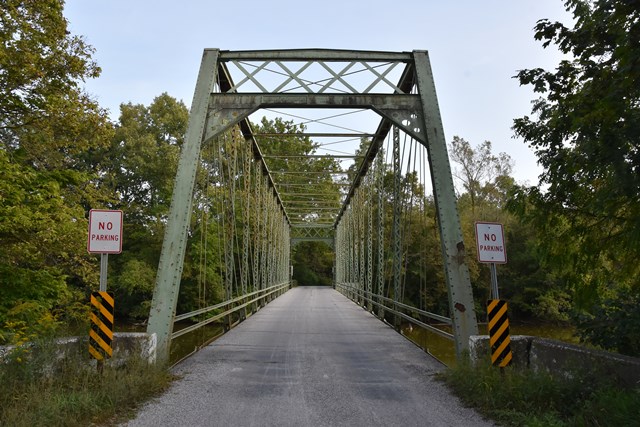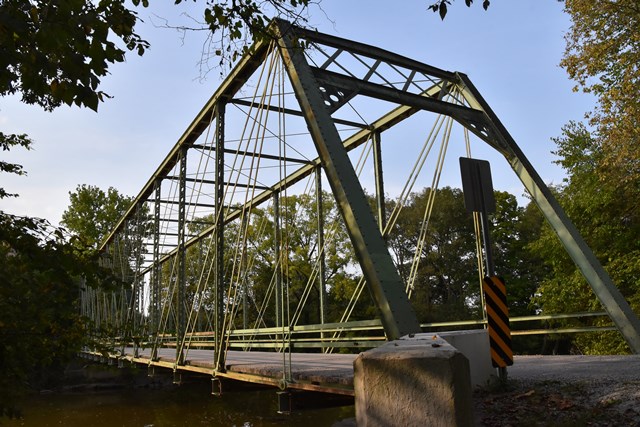We Recommend:
Bach Steel - Experts at historic truss bridge restoration.
BridgeHunter.com Phase 1 is released to the public! - Visit Now
Hurshtown Bridge
Van Zile Road Bridge, Allen County Bridge 32

Primary Photographer(s): Nathan Holth
Bridge Documented: April 2, 2006 and September 20, 2019
Hursh (Rural): Allen County, Indiana: United States
Metal 14 Panel Pin-Connected Whipple (Double-Intersection Pratt) Through Truss, Fixed
1883 By Builder/Contractor: Massillon Bridge Company of Massillon, Ohio
1999
175.0 Feet (53.3 Meters)
176.8 Feet (53.9 Meters)
15.7 Feet (4.79 Meters)
1 Main Span(s)
200022

View Information About HSR Ratings
Bridge Documentation
View Archived National Bridge Inventory Report - Has Additional Details and Evaluation
As of April 2006, Allen County still had four Whipple truss bridges! That is more Whipple truss bridges than is in the entire state of Michigan, which only has three! Indiana in general has a disproportionately large number of Whipple truss bridges compared to other truss types, when compared with other states. That said, Whipple trusses are still considered rare and significant in Indiana. This bridge is one of the more intriguing and beautiful bridges of the type, particularly because of the beautiful and unusual portal bracing on this bridge. The bridge is also quite old, with an 1883 construction date. The vertical members are rather unusual on this bridge, being very narrow and resulting in an unusual v-lacing appearance.
This bridge is a fourteen panel Whipple through truss, and features pinned connections. Whipple truss bridges are also known as double-intersection Pratt truss bridges. V-lacing is present on vertical members, and heavy lattice is present on the bridge on part of the extensive portal bracing. While the portal bracing is quite extensive, the sway bracing on this bridge is quite minimal with only struts present. The railings, which appear to be original, are also simple, consisting of two rows of channels. The 1999 restoration of this bridge appears to have replaced the flooring system of the bridge. Floor beams and hangers both appear to be new. The loss of original materials is unfortunate, but acceptable given that this has allowed the bridge to remain open to traffic, and the materials lost are not easily noticeable, especially to casual viewers. The retention of original railings, with no modern railings added is unusual, but maintains the historic appearance of the bridge.
Those who visit the nearby, over-rated Spencerville Covered Bridge and fail to visit this bridge are denying themselves the experience of true beauty in bridge construction. The ornate portal bracing, which is quite unique to this bridge, gives the bridge an impressive appearance. The complex geometric art formed by the attractive Whipple truss configuration only add to the beauty of this bridge. This bridge, which offers an excellent view of the scenic river, is just as beautiful as any covered bridge. Fortunately, this bridge was rehabilitated in 1999, and is in excellent shape. The 14 ton weight limit for this bridge is perfect for the light to non-existent traffic present on Van Zile Road. A nearby Ruth Road Bridge provides unrestricted crossing in the event that a truck needs to cross in this area. Hopefully, this bridge continues to be maintained, and given the same dignity that the nearby covered bridge has received. The Hurshtown Bridge stands today as a stunning tribute to the accomplishments of the Massillon Bridge Company, as well as to the truss bridge era.
In the photo gallery for this bridge, scroll to the bottom to view some additional photos from James L. Cooper, taken before the 1999 rehabilitation.
Information and Findings From DHPA Historic Bridge SurveyDescription Massillon fabricated a pinned, double-intersection Pratt (Whipple) through-truss span 24-ft. high and subdivided into fourteen panels. The endpost and top chord members were all made from a pair of channels riveted together with a cover plate above and battens below. The lower chord consists of pairs of die-forged eyebars which are heavier toward midspan. Aside from the pair of rods which serve as hangers for at the hip, the other verticals were fabricated from a pair of latticed channels riveted to pin plates above and below. With 7-in. channels, the outer intermediate channels are heaviest; the next two are 6 in.; and the most central five are 4 in. A pair of die-forged eyebars--growing smaller as midspan is approached--provide most of the diagonals. Cylindrical rod with turnbuckles serve as counters in the three panels on each side of center. Heavy latticed portal struts braced with open-circle decoration, struts of a pair of channels and pin-plates between upper panel points, and upper lateral bracing of adjustable rods, help to stiffen the trusses against the impact of moving loads. U-bolted to the lower pins, rolled I floor-beams support I-beam stringers that carry the asphalt-over-timber deck. A pair of channels line each truss as a railing. Allen County authorities made a major investment for the crossing of the St. Joseph River on an important roadway next to much-used mill. The commissioners selected a significant local mason to build the stone substructure and a prolific Ohio fabricator to design and erect the wrought iron superstructure. The Whipple--often reserved as here for long spans--is increasingly rare in the Hoosier landscape. The Hursh Bridge retains its original members, including its decoratively latticed portals and bracing. History The Board of Commissioners decided in April 1883 to seek bids for a bridge near Hursh's Mill on the much-used road between Fort Wayne, Cedarville, and Urbana in Allen County. The Board named Jerome D. Gloyd as superintendent of construction. When a month later the commissioners received proposals for the substructure and superstructure of the Hursh Bridge, they selected William Moellering to build the abutments with either Besen or Stony Point stone and the Massillon Bridge Company of Massillon, Ohio, to fabricate the iron superstructure. Massillon Bridge did not make the lowest proposal. Three proposals--one probably of timber and two for a combination of timber and iron--were lower, and the Mount Vernon Bridge Company brought in a bid at the same price as Massillon's at $35 per lineal foot for wrought iron. In all the Massillon Bridge span was contracted to cost the county $6,195 when erected to two coats of iron-clad paint mixed with boiled linseed oil. Moellering received $5,339.87 for his stone work. References Butler, Fairman & Seufert, Inc. Bridge Inspection /Reinspection Report: Allen Co. (Indianapolis: 1973, 1977, 1981). SIECO, Inc., Bridge Reinspection Report: Allen County (Columbus, 1993, 1995). Farrar, Garvey & Associates, LLC, Inc., Bridge Reinspection Report: Allen County (Indianapolis, 1997). bridge nameplate. Allen County, "Commissioners Record," R: 476, 536-540, 543-545; S: 242. Bridge Considered Historic By Survey: Yes |
This bridge is tagged with the following special condition(s): Unorganized Photos
![]()
Photo Galleries and Videos: Hurshtown Bridge
2006 Bridge Photo-Documentation
Original / Full Size PhotosA collection of overview and detail photos. This gallery offers photos in the highest available resolution and file size in a touch-friendly popup viewer.
Alternatively, Browse Without Using Viewer
![]()
2006 Bridge Photo-Documentation
Mobile Optimized PhotosA collection of overview and detail photos. This gallery features data-friendly, fast-loading photos in a touch-friendly popup viewer.
Alternatively, Browse Without Using Viewer
![]()
2019 Additional Unorganized Photos
Original / Full Size PhotosA supplemental collection of photos that are from additional visit(s) to the bridge and have not been organized or captioned. This gallery offers photos in the highest available resolution and file size in a touch-friendly popup viewer.
Alternatively, Browse Without Using Viewer
![]()
2019 Additional Unorganized Photos
Mobile Optimized PhotosA supplemental collection of photos that are from additional visit(s) to the bridge and have not been organized or captioned. This gallery features data-friendly, fast-loading photos in a touch-friendly popup viewer.
Alternatively, Browse Without Using Viewer
![]()
Maps and Links: Hurshtown Bridge
Coordinates (Latitude, Longitude):
Search For Additional Bridge Listings:
Bridgehunter.com: View listed bridges within 0.5 miles (0.8 kilometers) of this bridge.
Bridgehunter.com: View listed bridges within 10 miles (16 kilometers) of this bridge.
Additional Maps:
Google Streetview (If Available)
GeoHack (Additional Links and Coordinates)
Apple Maps (Via DuckDuckGo Search)
Apple Maps (Apple devices only)
Android: Open Location In Your Map or GPS App
Flickr Gallery (Find Nearby Photos)
Wikimedia Commons (Find Nearby Photos)
Directions Via Sygic For Android
Directions Via Sygic For iOS and Android Dolphin Browser
USGS National Map (United States Only)
Historical USGS Topo Maps (United States Only)
Historic Aerials (United States Only)
CalTopo Maps (United States Only)


